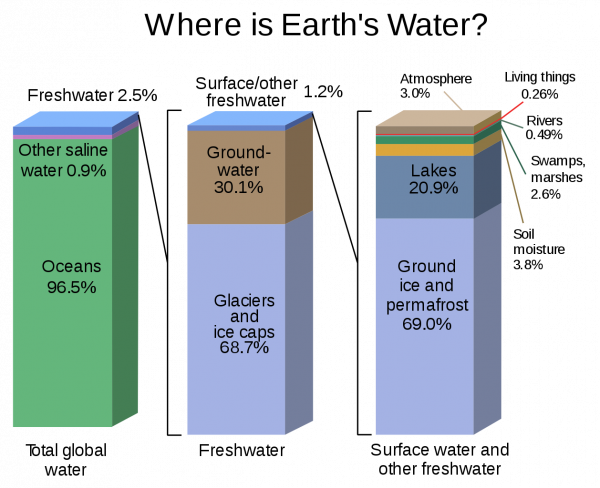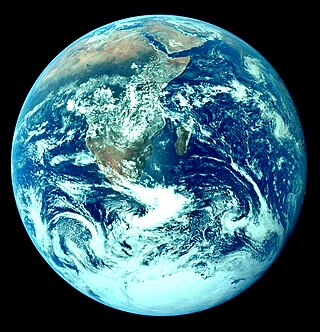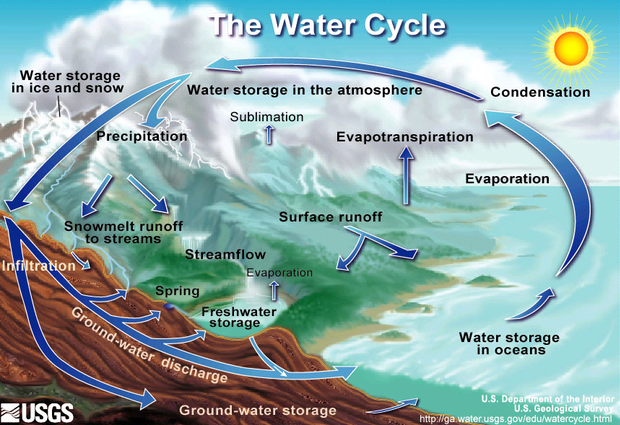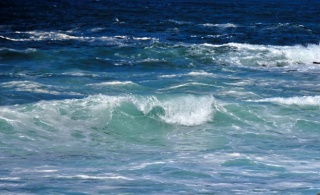Hydrosphere
From the darkness of space our planet is blue. This is because it has a hydrosphere and atmosphere. These outer shells surround the geosphere. In this learning pathway, we will find out about these important Earth systems.
In the infographic, on the water cycle (below), you can see the main elements of the water cycle, which involves the geosphere, the hydrosphere, and the atmosphere. Although H2O is mainly liquid, it can also be a gas in the atmosphere or a solid (ice) in the atmosphere, mountain tops, or ice caps.
The water cycle
The infographic indicating where is Earth's water tells us where the water is stored on Earth and in what form. Note that most of the water is in the liquid state in the world's oceans and seas and is salty. Freshwater is only 3% of all the Earth's water, and most of that is in the form of ice.

Earths water distribution
Review the following table summarising the earth's water reservoir and answer the question which follows.
| Reservoir |
Residence Time (average) |
| Ocean |
3,000 to 3,230 years |
| Glaciers |
20 to 100 years |
| Seansonal Snow Cover |
2 to 6 Months |
|
| Soil Moisture |
1 to 2 months |
| Groundwater: Shallow |
100 to 200 years |
| Groundwater:Deep |
10,000 years |
| Lakes |
50 to 100 years |
| Rivers |
2 to 6 Months |
| Atmosphere |
6 days |
- Which water reservoir holds its water the longest?
- The atmosphere
- Incorrect. Review the table above OR think a little "lower".
- The ocean
- Incorrect. Review the table above .
- Groundwater
- Correct. If you thought the answer was Ground Water you were correct. In some areas of the Great Artesian Basin that spreads west of Australia's Great Dividing Range into the dry inland, groundwater extracted can be millions of years old.
- Lakes
- Incorrect. Review the table above.
- They all hold water for the same amount of time.
- Incorrect. There is a better answer available to you, try again.
Does more water evaporate from the ocean, or from the land?
| Process |
From and to which Reservoir |
Flow Rate (km cubed) |
| Precipitation |
Atmosphere to Ocean & Land |
505,00km/year |
| Ocean Precipitation |
Atmosphere to Ocean |
398,000km/year |
| land Precipitation (exept snow) |
Atmosphere to Land and Surface |
96,000 to 107,000km/year |
|
| Eavotranspiration |
Ocean & Land to surface & Plants to Atmosphere |
505,000km/year |
| Ocean Evaporation |
Ocean to Atmosphere |
434,000km/year |
| Land evaporation |
Land & Surface to Atomsphere |
50,000km/year |
| Transpiration |
Plants to Atmosphere |
21,000km/year |
| Uptake by plants |
Land & surface to Biota |
21,000km/year |
| Runoff |
Land and Surface to Ocean |
36,000km/year |
| Melting |
Ice & Snow to Land & Surface |
11,000km/year |
| Snowfall (on Land) |
Atmosphere to Ice & Snow |
11,000km/year |
| Percolation |
Underground to and from Land |
100km/year |
- Select one from the below
- The Ocean
- Correct. Well done, there is a significant difference between the two, which leads us to the question below.
- The Land
- Incorrect. Consider using the table to your right.
If more water is evaporating from the ocean than precipitating into the ocean, how come we are worried about sea level rise?
Share your thoughts on the WeNote pannel below. We encourage you to share your thought, however, if you are stuck you can find the answer to this question at the bottom of this learning page.
- Ocean precipitation = 398,000 km3/year
- Ocean evaporation = 434,000 km3/year
Note: Your comment will be displayed in the course feed.
Match the explanation with the correct term
- Isostatic change occurs when the mass of continents increases or decreases due to the buildup of ice and snow. This process happens on geological timeframes while glaciers build up at the onset of ice ages (increasing the mass of continents), and melt as ice ages end (decreases the mass of continents). When the continent's increase in mass, land sinks deeper into the ocean, increasing sea levels.
- Warming of oceans
- Incorrect. Unlucky, try again.
- Changes in Land Masses
- Melting Icebergs
- Incorrect. Unlucky, try again.
- Melting Ice Caps
- Incorrect. Unlucky, try again
- When the oceans warm, water molecules take up more space, increasing the volume of the ocean. This is called thermal expansion
- Melting Icebergs
- Melting Ice Caps
- Changing land Masses
- Warming Oceans
- as global temperatures rise, ice caps melt and the runoff flows into the oceans. This shouldn't be confused with melting Icebergs, although some fraction of an iceberg is above the surface, the volume of liquid water is smaller than the volume of frozen water for the same number of molecules, therefore, ice already floating in the ocean has a negligible effect on sea levels.
- Melting Icebergs
- Melting Ice Caps
- Changing land Masses
- Warming Oceans
Water - Unique characteristics that make water what it is.
In this section, we consider the unique properties of water, and how these affect global temperature, weather and climate.
Unusual Properties of Water
| High boiling point |
High melting point |
High specific heat |
| High heat conductivity |
High heat of evaporation |
High heat of freezing |
| Maximum density at 4°C (pure water) |
High surface tension |
High viscosity |
| High dielectric constant |
|
|
|
How do these unique properties of water affect global temperatures?
- The oceans can hold a lot of energy without changing temperature – thermal inertia
- Important vehicle for heat and energy transfer between the oceans and atmosphere
- Transfers energy from the equator to the poles
- Thawing and freezing of ice at the poles moderates global temperatures, absorbing and releasing energy without changing ocean temperatures
What about ocean circulation? How does that affect weather and climate?
- Ocean circulation can be divided into surface and deep currents
- The surface currents are driven by the winds, by the rotation of the earth, and by differences in seawater density, which cause differences in the height of the sea surface
- Deep ocean circulation, also known as the thermohaline (thermo = temperature, haline = salt) circulation, is driven by density differences, caused by differences in temperature and salinity
- Both deep ocean and surface ocean circulation move heat, gases, and nutrients around the planet, and play a key role in climate and weather
- Learn more by watching this short video on the deep ocean circulation and its role in climate
Summary
Now that you know some interesting things about the hydrosphere have a look at the next page on the atmosphere.
WeNote Activity: If more water is evaporating from the ocean than precipitating into the ocean, how come we are worried about sea level rise?
- Answer: Although more water evaporates from the ocean, river runoff from the continents into the ocean make up the balance.



